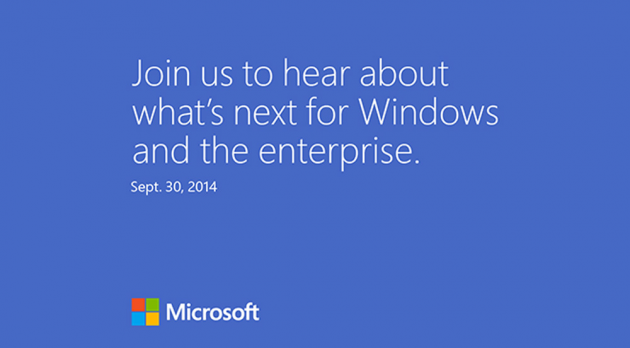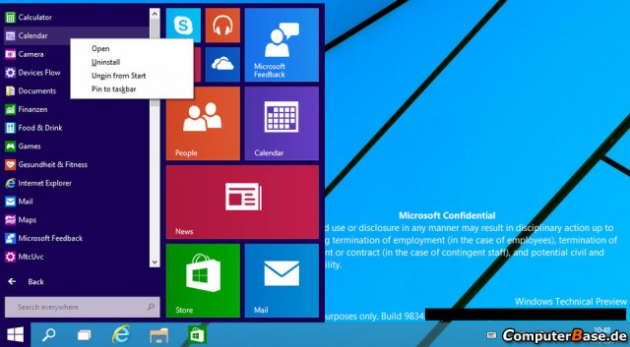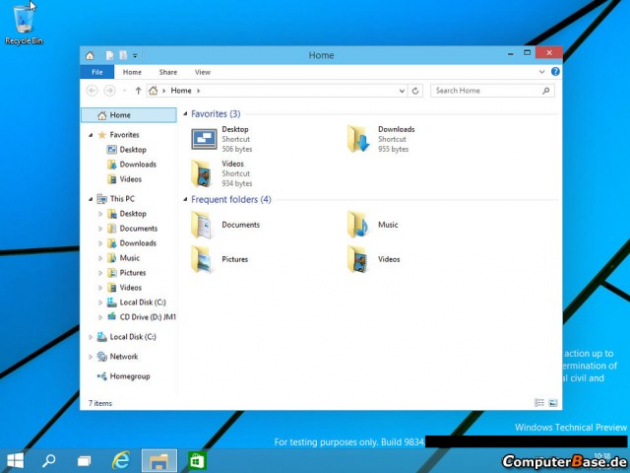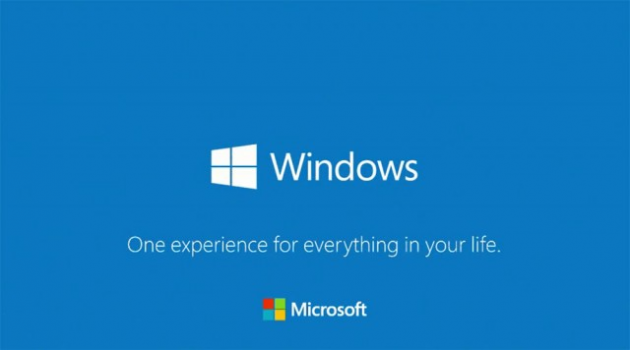What Is Known Already About Windows 9 Threshold Ahead of September 30 Microsoft Event
The buzz about the upcoming replacement for the somewhat maligned and unpopular Windows 8/8.1 is mostly positive. The tech press are expecting something new and something old in a Windows 9 Threshold package (the final product name has yet to be finalized despite the French Microsoft regional head naming it Windows 9 and then quickly retreating in predictable French fashion).
Microsoft has invited the assorted technology press to attend their own splashy event on September 30 to discuss their plans for Windows and the enterprise, is how they put it. Nothing else was really disclosed and the officials have been “keeping mom” about the details beyond that.
Thanks to some choice Windows 9 technical leaks of various builds along the way it has been possible to piece together from the alpha versions what new features were being tested, trialed and later abandoned as the development process continued. It is fair to say that during development Microsoft software build screen shots were leaking like a sieve even if the actual alpha software was not.
Windows 8 Problems
Windows 8 has had its detractors to be sure. Whether the software is the Windows 8 or the updated 8.1, the abandoning of the traditional Start menu was a disaster.
The assumption made that everyone would immediately move over to touch screen monitors or LCD screens (and wanted to lay waste to them with a litany of oily fingerprints all day in the office) was a wrong-headed one.
The colorful MetroUI Start screen with the traditional Windows desktop seemingly hidden elsewhere created lovers and haters of the new flatter GUI in equal measure. There have been far fewer adopters up to the latest version of Windows than had ever been expected because of doubts over these issues for individuals and businesses alike.
Surprisingly many users are still stuck back in Windows XP land and despite no longer receiving Windows updates, they're not budging until they get something really impressive to upgrade to because they'll need all new hardware to go with it and that gets expensive real fast especially for an entire department or company wide.
Discover the Start menu; Again
Microsoft thankfully seems to have been listening and early builds showed the return of the expanded Start menu on the Windows desktop in Windows 9 known internally as Threshold. Some screen shots have the development team combining a wide Start menu with the Metro UI tile effect that has been used on the Start screen in Windows 8. Microsoft may not be willing to completely do away with the Metro UI just yet.
This one change to bring back the Windows desktop as a core feature and return the Start menu to its rightful place will at the very least remove one major obstacle from businesses and individuals who may have been put off upgrading before. Disgruntled Windows 8/8.1 users can upgrade and get the Start menu back fully and users of other versions can benefit from performance improvements.
Start Screen Tweaks
The Start screen for tablet users is expected to have live tiles that can be resized and show current informations on updates and notifications from individual apps. It is also likely that a tile can have smaller icons to indicate features included with the app before launching it.
Virtual Desktops
Long something that power users added via a third party app, virtual desktops are expected to be included in the version of Windows 9 that will be released to the public. Virtual desktops has been part of the Mac OS X functionality for some time and are also included in several Linux operating systems including the popular Ubuntu distribution.
This native feature will require more available RAM memory to operate and a PC with a decent amount of processor performance as to perform tasks on multiple virtual screens uses more resources than a single desktop would do.
Metro Apps on the Desktop
One of the serious restrictions with Metro apps that are based in the Start screen in Windows 8/8.1 is that they cannot be run on the Windows desktop in their own screen. This means that users were forced to access the Start screen to use the Metro apps they wanted. This restriction divided up functionality between what you could do on the Start screen and what you could do from the regular Windows desktop. A bad idea.
This is being changed so that Metro apps will be able to run in their own window on the Windows desktop itself. It is expected that apps will be responsive to keyboard and mouse interactions which will remove the requirement to use a touch screen and perform a lot of mouse scrolling to find the tile you need to tap on to access the Metro app you wish to use. This change will remove quite a bit of the frustration experienced by users who upgraded to Windows 8/8.1 already.
Flatter Design
As has been the trend across platforms and design aesthetics lately, the design UI with Windows 9 has become almost completely flat. The borders are barely 1 pixel wide. Many of the icons are already very flat without 3D aspects, but others still retain their 3D design elements in early builds. It is expected that they'll all become flat and lose much of their 3D design cues in the final production version of Windows.
One OS With Two Different GUIs?
This one is unclear presently. Will Microsoft retain the Metro UI for touch screen and tablet users when they merge the Windows operating system into a single package and offer a different GUI with the traditional Windows desktop driven by keyboard and mouse for desktop, laptop and server PCs?
The current retention of the Metro UI in the new Start menu has led to confusion on what the final Windows experience will be. It may be likely that in order to merge Windows versions into one each user could be given a choice upon installation as to which Windows visual experience they wish to enjoy. This would be similar to how changing a Windows theme works and alters the look and feel on the desktop after the switch. In this case, likely Windows 9 will detect your hardware and determine which GUI should be the default but still allow the installer to change that pre-selection and the user to switch between them later if they wish (perhaps they buy a touch screen monitor later and wish to try that version of Windows GUI now).
Charms Bar Disappearing on the Desktop
The Charms bar may be removed from the Windows desktop to remove clutter but still be included in a touch screen display version. In some versions viewed of early Windows builds the notifications panel was seen popping up from the corner of the desktop.
Multi-Monitor and Hi-Res Support
There will likely be greater support for multiple monitor setups. More people now use 2 or 3 monitors than every before as the prices of quality LCD monitors have fallen markedly from where they were just a years ago. High resolution setups are also likely to get improved support to allow for improved desktop publishing that requires high DPI for magazine and poster publishing work.
Cortana Digital Assistant
The Cortana digital assistant that is seen currently on the Windows Phone is being ported across to Windows 9 to help users with their general queries in much the same way as Siri does for Apple users.
The filtered searches on Cortana will be useful for Windows users who can ask the service to find all their vacation photos from 2010 and the tool can search their hard drive for that media. This sort of benefit can save time hunting for photos and other files you can never seem to locate because they were never saved in an organized manner.
Notifications Panel
It is expected that a fully featured notifications panel will be available from the desktop. Users are now familiar with these panels if they have used Android or iOS lately so it is not surprising that Microsoft are going more into updateable information on the desktop. This may be incorporated into the new Start menu as well as the Start screen depending on the GUI used.
One Click Upgrading
It is believed that the upgrade path will be made much simpler for users of Windows 9. Upgrading later to Windows 9.1 or Windows 10 will be able to be done with a quick click and a fast internet connection to both download and install the new Windows version.
The faster release cycle that has been evident from a number of the key development teams at Microsoft indicates that updates will be more frequent than they have been in the past. As has been the case with the highly successful Office 365 cloud product, the move for Windows to the cloud for new versions and updates seems inevitable.
With that said it is likely that the Windows OEM disc versions will still be made available for builders and sellers of new PCs and laptops to get around the thorny issue of a new PC buyer having an internet connection that's too slow to download Windows and coming unstuck.
Iterative Updates
In keeping with the gradual but more frequent updates of the Mac OS X operating system, it seems that Microsoft will move more towards this approach with their software releases. Cloud version availability for Windows will only make this approach easier as well.
Universal Apps
With the move to a single operating system approach, apps are expected to work universally in Windows 9. This would make the operating system the workhorse that determines how to run a certain app on a certain type of computer system instead of an app only being able to run on a specific type of hardware.
The latter is more approachable, the former harks back to the bad days of numerous computer brands none of which were compatible with each other until the IBM compatible computer came along to lay a path that could be followed to broad-based compatibility and interoperability.
The event on September 30 is sure to be an interesting one for any long-term users of Windows who wish to confirm what is coming next.
Images source: ComputerBase.de




